Assessing the Remnants
After the Great LeMons South Race of 2008, the valiant and noble chariot that brought us Index of Effluency fame was unceremoniously dumped off the car hauler under a cluster of pine trees in my backyard. A standard-issue blue tarp was thrown over the top, to protect the seat and harness from the elements, and a few tires piled on top to secure said tarp. And there it sat.
Despite this treatment, we were all very much indebted to the courageous Amazon, and had every intention of ressurecting her for the races in 2009. Chief Perpetrator, Jay Lamm, must first be consulted to determine the "residual value" of the car. As the 24 Hours of Lemons requires that all cars must be prepped for less than $500, whatever $500 minus the assigned residual value of the car equals is the amount allowed to be sunk into the rolling money pit for repairs and improvements. So, after the July 2008 race, I emailed Jay:
"One other question for you. We all had such a great time that we'd like to re-enter the 122 for next year's LeMons at CMP. As such, we'll need to know what our car's "residual value" is so we know what we can spend to improve it. As you can probably tell, we like to play within the spirit of the rules, and we honestly did not spend more than $500 on the car, not counting wheels, tires, brakes, and safety gear. Hell, even the wheels were pretty much free and I think we only spent about 40 bucks on brake pads.
Anyway, let me (us) know so we can start thinking about next year. And once again, great race!"
To which I received this amusingly frank reply:
"Let's call it scrap value: $200 residual. God knows nobody other than the smelter will buy that car off you...."
We have $300 to play with! Woo-Hoo! Nitrous Injection, here we come!
OK, not really. The reality of the situation is, we now have about 2 1/2 months to go before the next race (April), and the consensus among all involved was that we wanted to improve handling (such as there was any) and reliability.
Sometime in December...
We decided to kick off the 2009 season right, with a dinner party hosted by Rob, and in 2008. Rob's better half Marilyn was out of town on business, leaving Rob to his own devices to prepare us all food. And prepare food he did. We feasted on homemade bread, pasta, meatballs, salad, and numerous fermented beverages, including the very apt Lemon-tini. Many of the Chuckettes attended as well, and the youngest "chuckers", Nathanial and Allison, came to marvel at the silly adults and their racing cars. No photographic evidence exists of this historic meeting, and the women folks all got plastered off of the Lemon-tinis, which they will all now deny.
Sometime in January...
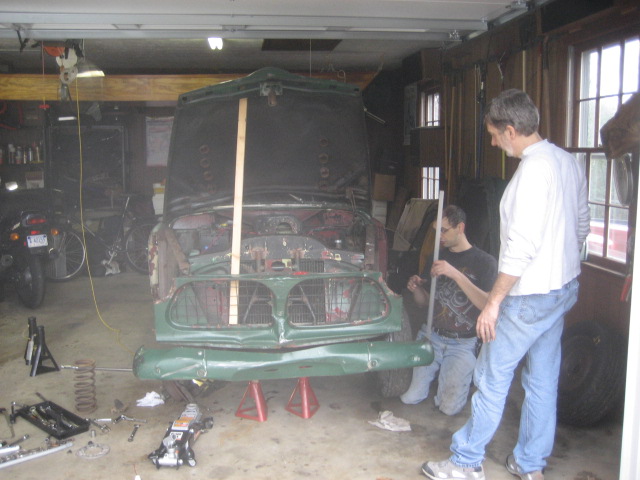
The drought that besieged much of the Southeast during 2008 finally broke, and the hallowed ground which spawned many a work session (my barn) turned into a deep clay muck. Luckily, Rob lives in nearby town where they have discovered the blessings of concrete, so the Lemon was de-tarped, extracted from my backyard onto the trailer, and relocated to Rob's garage. In the process, his wife's BMW wagon was displaced to the driveway, and I'm sure this caused absolutely no consternation whatsoever.
Above is the illustrious Amazon, getting settled into its new surroundings- mostly Rob's antedulluvian tools (more on this later) a canoe, and about a dozen motorcycles. We've removed the wings here, to allow easier access to the front suspension and also to perform some rudimentary bodywork. If you may recall, we had some (ehem) interactions with a 123-body Mercedes, an RX-7, and a Caprice (to name a few) and some metal ended up displaced. Click here to view the damage.
From a handling perspective, one of the greatest challenges we had to overcome was that, by and large, our car had the greatest amount of ground clearance of any other vehicle on the track. This includes the tow truck that was employed on more than one occasion to retrieve our crippled car from the course. Tire clearance (read: wheels lifting off the road) was another, related problem we had. See below:
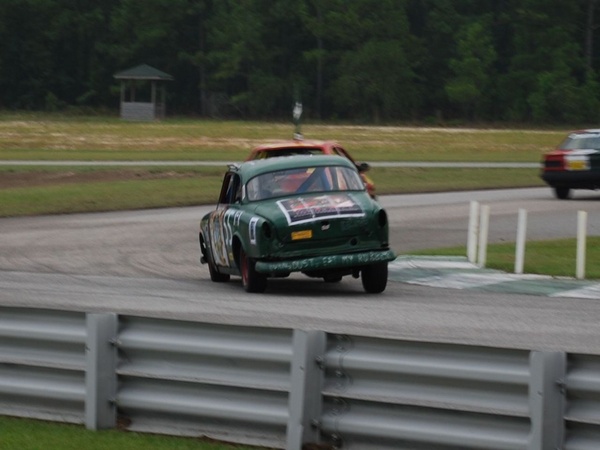
In order to lower the car, the springs needed to be shorter. This could be accomplished in one of two ways. For a normal, high-dollar build, one would call up a performance shop and order a set up shiny, powdercoated springs, manufactured to precise tolerances and spec'ed to the desired rate. Or, if you are us, and working on a $300 budget, you grab a Dremel tool and a torch and you cut the 40-year old stock springs.
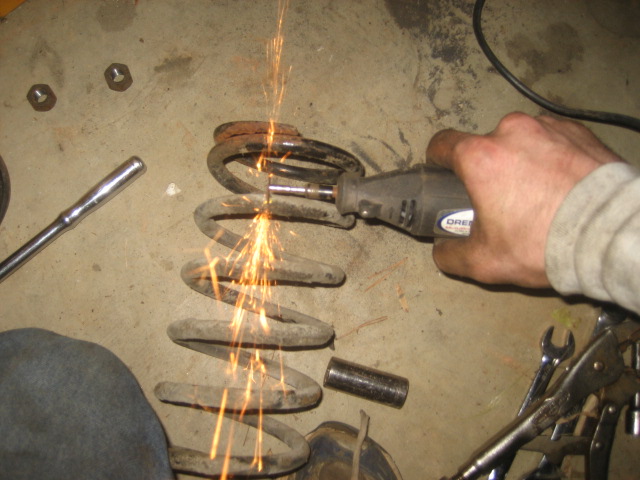
Believe it or not, I took this picture while using the Dremel.
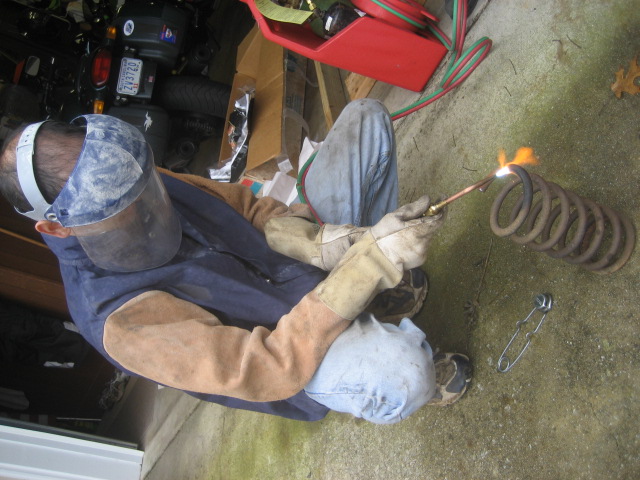
Here, Brian learns that fire makes metal soft and bendy. The trick, however, is to heat the metal just to the point where it becomes soft and bendy, and not to the point where it changes color, otherwise you disrupt the molecular structure of the metal and end up with a coil of wood. Or possibly styrofoam. In any case, it won't be very good at being a spring.

PUSH!
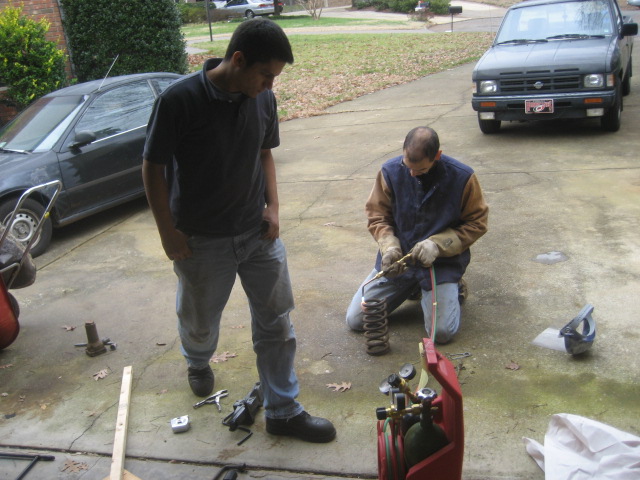
Anthony skillfully avoids the pyromaniac and his flame.
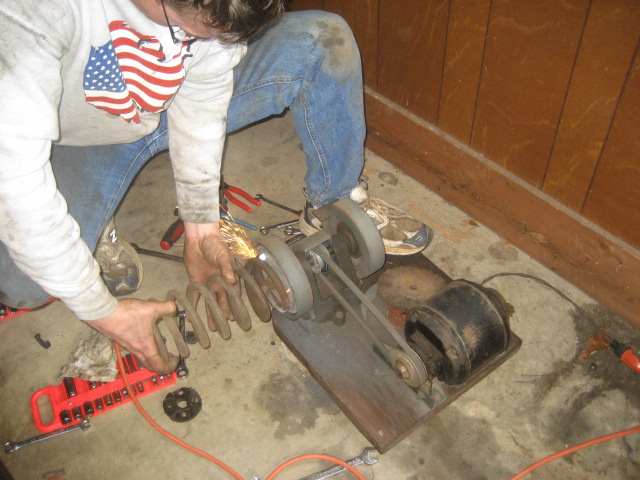
To add that finishing touch, I ground the ends of the newly-shortened springs flat. This bench grinder is an example of Rob's shop tools. Somehow, Rob seems to have everything you need, but its always just a little bit different from what you'd expect. I'm pretty sure this bench grinder pre-dates the Volvo itself, and in any case defitely pre-dates OSHA. There is no on-off switch, the wires coming out of the motor are a twisted pair (insulated with hopes and dreams) and the belt flops around wildly during use. Also, the board isn't secured to anything, so you have to stand on while you use it. For added safety, I've removed my dangerous work gloves.
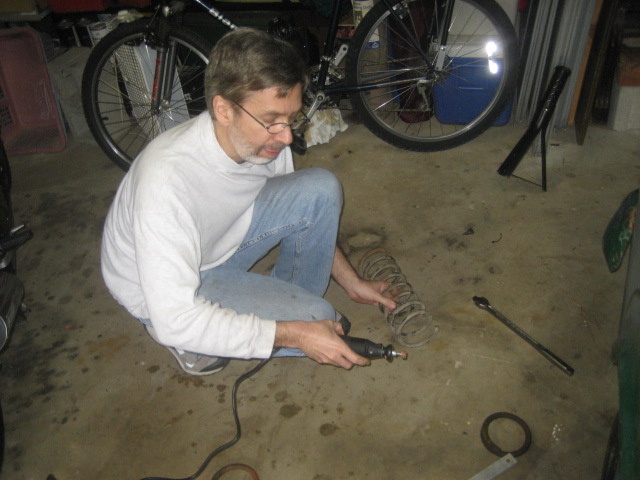
Rob, of course, wanted nothing to do with his bench grinder, and stuck with Dremeling the sharp edges of the coils smooth.
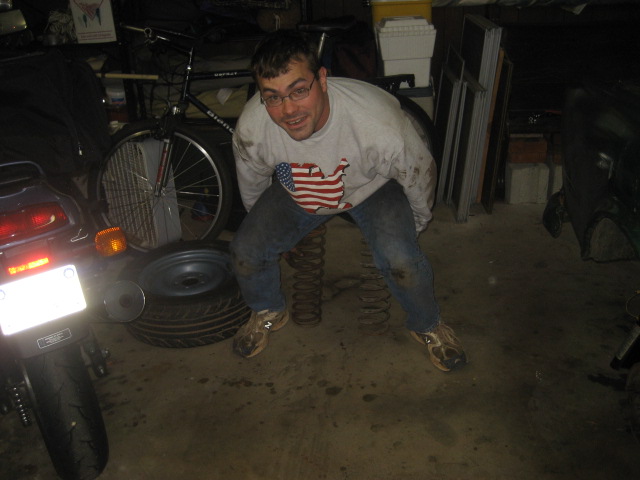
This is a very bad picture of me testing the spring rates. Brian thinks this looks like I am having a coiled, metallic bowel movement. His scatalogical sense is amazing.
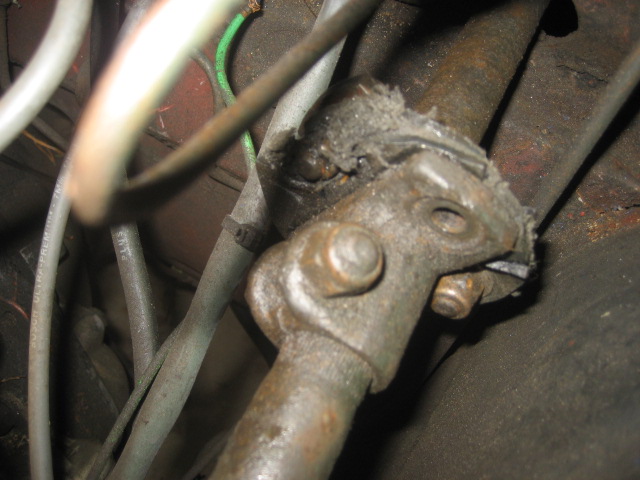
In going over the car, we noticed lots of little things that made us cock our heads sideways and make small, disconcerted-sounding noises. This one made us do double takes. That shredded, disintegrated-looking thing in in the above picture is the steering axle coupling. Somehow, we overlooked this in our initial race prep, or perhaps 2 days of flat-out driving on a 40-year old rubber biscuit was more than it could take. At any rate, we reached deep into our team's pocketbook and shelled out $4 for a nice, new red poly bushing from IPD.
We did a few other things on this, our first official work day of the 2009 season. We unbolted the front calipers and Rob began disassembling and cleaning them. They'd leaked pretty badly at the end of the last race, and the intention is to rebuild them, and replace the hoses and other rubber parts. Since improvements to the brake system aren't included in the $500 prep limit (like any other safety-related items) we are free to improve and rebuild there as we see fit. We'll take a look at the brakes more thoroughly in the next work session, so for now I'll leave you with the fruits of our lowering labors. I give you one Volvo Amazon, lowered approximately 17 1/2 inches:
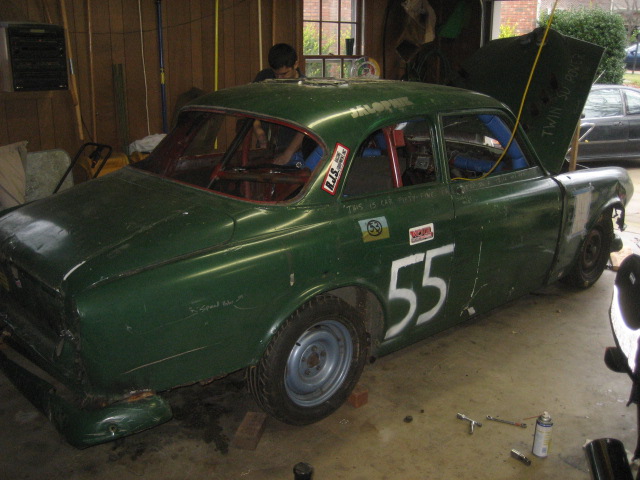
Click somewhere on the left column to read more of our adventures.